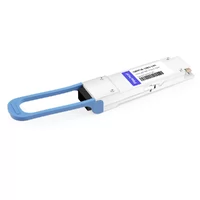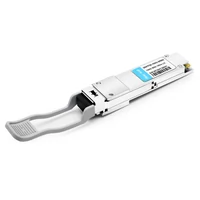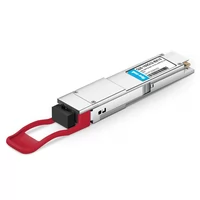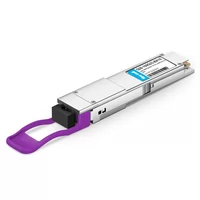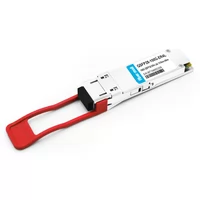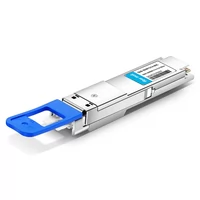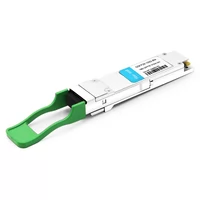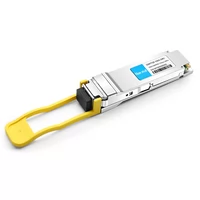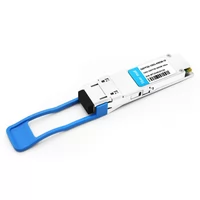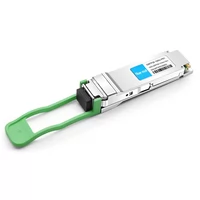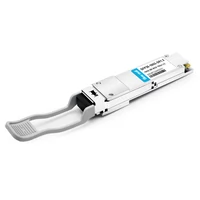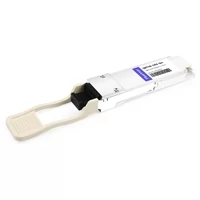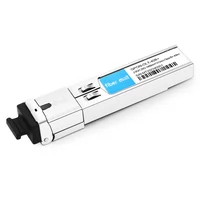The fast-changing area of networking technology has led to the need for higher bandwidth solutions, creating high-tech transceiver modules. Among others, the Cisco QSFP28 Transceiver is regarded as one of the best for 100G networks, with its ability to handle different uses such as enterprise backbone and data centers. This guide seeks to explain what QSFP28 technology is all about by looking at its functions, features, and compatibility with current infrastructures. Through technical talks coupled with practical insights, readers will be enlightened on how these modules improve network efficiency and reliability in today’s data-oriented environments.
Table of Contents
ToggleWhat is a Cisco QSFP28 Transceiver Module?
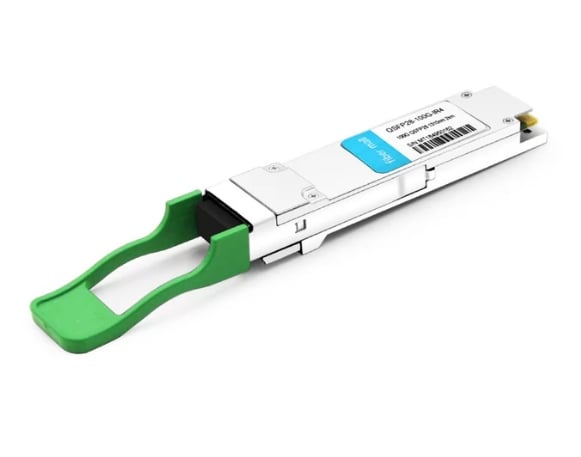
Understanding the QSFP28 Form Factor
The QSFP28 (Quad Small Form-factor Pluggable 28) is a high-density transceiver that provides data rates up to 100 Gbps in a small package. It uses four lanes for electrical signaling at 25 Gbps each, which allows it to work well with both single-mode and multimode fiber. This form factor is critical for maximizing space within networking equipment while still providing the best performance possible in data centers and other high-bandwidth applications. Its ability to be hot-swapped makes it easy to upgrade or replace without interrupting the network, and its standardized pin configuration means that many different types of networks can use it. All these features combined make the QSFP28 an essential part of modern network architecture.
Key Features of Cisco QSFP28 Modules
Cisco QSFP28 modules have a number of important features that increase their efficiency and effectiveness in speedy networking environments:
- Support for High Data Rates: Designed to accommodate rising modern data traffic needs, QSFP28 modules can support up to 100 Gbps data rates.
- Application Versatility: These modules find uses across various fields such as data centers, enterprise networks and high-performance computing settings including 100GBASE-DR Single Lambda 1310nm 500m transceivers configurations.
- Single-Mode and Multimode Support: Depending on distance or bandwidth requirements, these units work optimally over both single-mode fiber optic cables as well as multimode ones thus providing deployment flexibility.
- Increased Energy Efficiency: Developed with energy conservation in mind therefore they transmit bits at lower power levels which saves costs over time when using QSFP28 module transceivers.
- Hot-Swappable Design: The hot-swapping ability enables easy replacement or upgrading of the transceiver without powering down the system, thereby reducing downtime and ensuring uninterrupted network services.
- Strong Compatibility: Ensuring compatibility among different types of network devices is made possible through standardized pin configurations used in Cisco QSFP28 modules hence simplifying integration into established systems.
Cisco’s suite of features showcases how vital its QSFP28 Modules are within the high-speed networking solutions continuum.
Applications of QSFP28 in Data Centers
QSFP28 modules are critical to modern data centers because they can increase efficiency and performance by offering high-speed data transfer capabilities. They also work with different architectures like Ethernet L3 data center switches. These tiny transceivers take up less space in areas that have a lot of density, so more of them can fit into a small area, creating larger bandwidths without needing to expand the footprint. Moreover, switch-to-switch and switch-to-server connections utilize this technology to enhance data throughput and minimize latency — two features required for cloud computing or virtualization.
In addition, high-performance computing (HPC) applications benefit from the use of QSFP28 modules due to their ability to support bandwidth for large workloads, which prevents server communication bottlenecks between systems. Since both modern and old systems are compatible with these devices, it allows data centers an incremental upgrade path while still integrating new technologies easily over time without losing money spent on legacy infrastructure investments. Thus, the overall quality characteristics of QSFP28 modules match customizable designs that meet changing demands in efficient, scalable enterprises.
How Does the Cisco QSFP-100G-DR-S Transceiver Module Work?
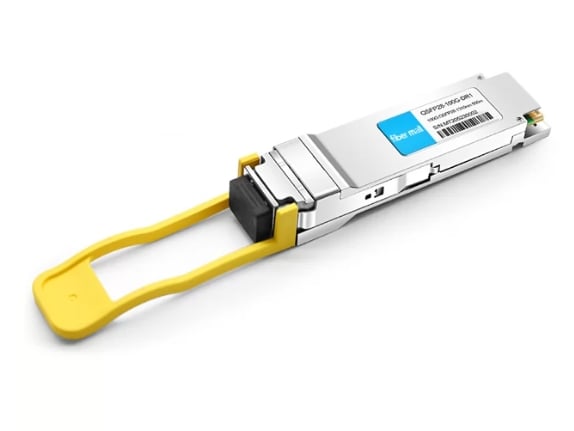
Technical Specifications and Wavelength
The transceiver module QSFP-100G-DR-S by Cisco is designed for high-speed interconnections using multimode fiber, particularly in data centers. The module’s working wavelength is 850 nm, and its data rate is 100 Gbps. This equipment complies with IEEE standard 802.3bm, which guarantees its compatibility with current and future networking technologies.
Looking at the specs, the QSFP-100G-DR-S can reach up to OM3 multimode fiber over distances as long as 70 meters or even longer when using OM4 (up to 100m). It easily connects multiple devices within different areas of a single data center since they all fall under these categories. For transmission purposes, this module uses four lanes, each lane carrying 25Gbps, hence maximizing bandwidth efficiency while consuming only about 3 watts per hour, thus being environmentally friendly.
Single Lambda and Duplex LC Connectors
Single lambda technology uses a single wavelength for data transmission. This allows for better bandwidth efficiency and less signal degradation, which makes it perfect for high-density environments. Duplex LC connectors are small and have two channels that can send and receive data simultaneously over optical fibers. This arrangement enables faster data transfer and saves space in racks within data centers. Single lambda technology combined with duplex LC connectors creates an efficient solution to today’s networking requirements, leading to enhanced performance with simpler interconnect designs.
Benefits of 1310nm 500m DOM Duplex
The use of 1310nm 500m DOM duplex modules in data communications has numerous benefits. To begin with, this device has the capacity to transmit signals over a longer distance, which is up to five hundred meters on multimode fiber, and thus provides reliable connections within data centers. In addition, because it operates at a wavelength that is less likely to be affected by chromatic dispersion, signal quality improves, resulting in fewer errors for longer runs. Furthermore, digital optical monitoring (DOM) enhances the ability for real-time diagnostics by allowing network managers to monitor performance indicators like optical power and temperature, hence improving reliability while making maintenance easier. Finally, its duplex design supports two-way data flow, so there can be high throughput without sacrificing any performance.
What Makes 100G QSFP28 Transceivers Unique?
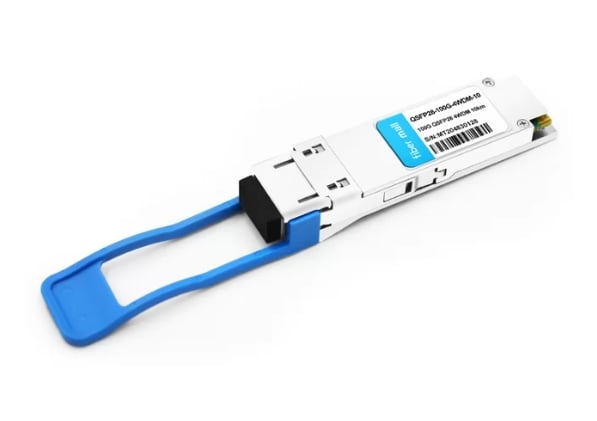
High Data Rate and Low Latency
The defining feature of 100G QSFP28 transceivers is their ability to transmit data at speeds of 100 gigabits per second, significantly increasing bandwidth capacity for modern data center applications, particularly when used in an Ethernet L3 data center switch. Advanced modulation techniques and multiple lanes of optical transmission are employed to achieve this high data rate, which enables efficient handling of data in environments with the highest demand. These transceivers are also engineered to provide low latency, which is critical for applications that require near-instantaneous data transfer like high-frequency trading, real-time analytics, and HD video streaming. Network designers view these transceivers as a must-have since they have both speedy rates and little delay – two key features that make them ideal for connecting complex systems over long distances without losing bandwidth or speed along the way.
Compatibility with Various Cisco Modules
The Cisco Nexus and Catalyst modules are designed to work with 100G QSFP28 transceivers. This makes it easy to include these transceivers in existing infrastructures since they mainly interact with the Cisco Nexus 9000 series switches and Catalyst 9500 series. In addition to other Cisco optics, this allows for interoperable connectivity between different networks which improves overall performance. The flexibility of using various types of 100G QSFP28 SFPs in conjunction with different kinds of Cisco modules is critical for businesses that want their networking systems upgraded without disrupting their integrity or efficiency. Furthermore, compatibility reaches beyond just third-party devices alone; thus making them viable options across multiple networking environments.
Compliant Standards and MSA
The 100G QSFP28 transceiver is a crucial component in ensuring reliable and interoperable connections across different networking environments. Among these include the 100GBASE-DR Single Lambda 1310nm 500m connection. There are several standards that govern this device, some of which include the IEEE 802.3by for 100G Ethernet, as well as MSA (Multi-Source Agreement) specifications on form factor design, electrical interfaces, and optical performance, among others. Compliance with these standards ensures that not only do they meet high-performance criteria but also allow interoperability between products from various manufacturers when deploying SMF optical transceiver modules used in wide area networks (WANs). This alignment helps build strong network deployment and scalability thereby enabling organizations to use diverse networking solutions while still maintaining top-notch performance within their infrastructures.
How to Choose the Right QSFP28 Transceiver Module?
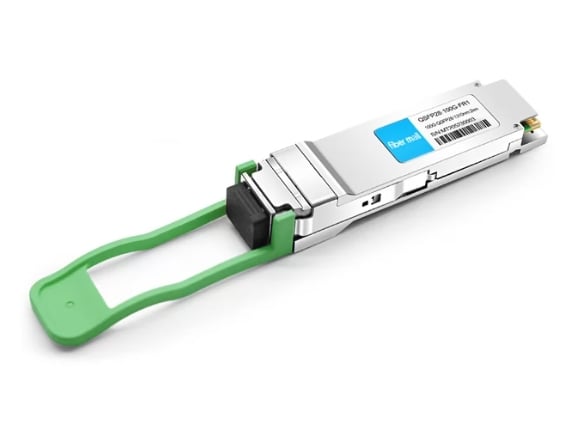
Factors to Consider: SMF, Wavelength, and Distance
There are three major factors when choosing a QSFP28 transceiver module: the type of fiber optic cabling (Single-Mode Fiber or SMF), operating wavelength, and distance. Single-Mode Fiber is meant for long-distance communication, so it allows higher bandwidths, which makes it ideal for core network applications in QSFP28 transceivers. The operational wavelength usually ranges from 1270 nm to 1330 nm in an SMF environment but affects performance as well as compatibility with different configurations of the transceiver. Finally, knowing what transmission distances are required is important because various models of QSFP28 have specific optimization ranges thus ensuring that they fit within your infrastructure capabilities while meeting performance requirements on a wider scale. Organizations will be able to enhance their network’s efficiency and reliability by considering these aspects carefully before making any decisions about them.
Comparing Cisco QSFP-100G-FR-S and Other Models
When it comes to transceiver modules, the Cisco QSFP-100G-FR-S is not one that can be overlooked. This particular model was made for long-range optical transmission over Single-Mode Fiber at a wavelength of 1310 nm and can support distances up to two kilometers, making it ideal for data center interconnections and metropolitan area networks. Other models, such as the QSFP-100G-LR-S, are meant for longer distances (up to ten kilometers), while others, like the QSFP-100G-SR-S, only target shorter ranges (about three hundred meters) use Multi-Mode Fiber instead. Furthermore, in high-speed applications where performance related to data integrity and minimal signal loss are critical, this specific module usually excels compared with other types. Thus, when choosing which transceivers will work best together within your network system, you must evaluate their distinct features based on different use cases involved therein, along with any requirements they may have specific to them alone.
Ensuring Compatibility with Network Infrastructure
To make sure a transceiver module like the Cisco QSFP-100G-FR-S is compatible and performs well with your existing network infrastructure, you need to look at it carefully. For example, one important factor is whether Single-Mode or Multi-Mode fiber optics are being used because this can influence which kind of transceiver should be selected (e.g., a single-mode QSFP28 1310nm module). It’s also essential to check switch/router specs since not all devices work with every type of transmitter or data rate. In addition, think about the network architecture such as long-haul segments that might exist between different parts and interconnections that could require selection based on distance bandwidth requirements. If organizations align their transceivers meticulously with their networks, they will improve efficiency and reliability for data transmission while reducing possible operational problems.
Installation and Maintenance of Cisco QSFP28 Modules
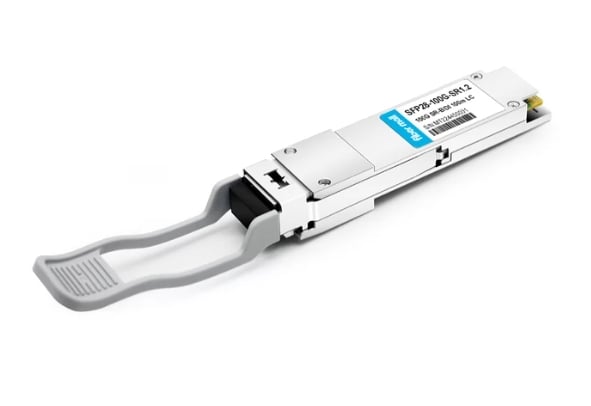
Steps for Proper Installation
- Confirm Compatibility: Ensure that the chosen Cisco QSFP28 module is compatible with the current switch or router and can support the stated data rate.
- Cable Inspection: Verify that the type of fiber optic cabling used – Single-Mode or Multi-Mode – corresponds to what is required by the transceiver module.
- Prepare Your Environment: To avoid any electrical damage during installation, power down your network device.
- Remove Existing Module: If necessary, carefully take out any transceiver modules that may have already been installed in ports.
- Insert New Module: Align the QSFP28 module with its port and press it firmly until it clicks into place securely.
- Connect Fiber Optic Cables: Connect appropriate fiber optic cables ensuring they are tightly secured to transceiver ports.
- Power Up Device: Turn on your network device and watch for successful recognition of modules as well as link status monitoring.
- Testing Procedure: Run diagnostic tests which will validate data transmission thus guaranteeing optimal performance.
Troubleshooting Common Issues
Troubleshooting Cisco QSFP28 modules involves a methodical approach to identifying and resolving issues. Here are some common problems and their solutions:
- No Link Detected: Check that the QSFP28 module is seated correctly in the port. Ensure that the attached fiber optic cables are intact and securely fastened. Furthermore, verify that the module is compatible with your switch and check if it is powered on, particularly when using lambda 1310nm 500m DOM duplex transceiver.
- Intermittent Connectivity: Take a look at the fiber optic cables for any bends or physical damages that might affect signal transmission. Running diagnostic tests can help find out if there are any network configuration conflicts or errors affecting connectivity especially after deploying a new QSFP28 1310nm module.
- Underperformance: Speed tests should be done to measure data throughput against expected performance metrics. If performance falls below standard, consider checking for network congestion and optimizing routing protocols as these two things can heavily influence data flow.
- Device Does Not Recognize Module: If the device inventory does not show this module then make sure your firmware is updated because an outdated version could cause compatibility issues so check Cisco’s website for updates on this issue.
Network administrators can improve Cisco QSFP28 modules’ reliability and performance by systematically addressing each of these problems ensuring they have a strong network infrastructure.
Maintenance Tips for Longevity
To make sure that Cisco QSFP28 modules last a long time and work efficiently, keep in mind the following maintenance tips:
- Frequent Cleaning: Use lint-free cloths and suitable cleaning solutions periodically on optical connectors of the module. This will help you remove dirt or other contaminants that can interrupt signal transmission.
- Control Temperature: Check the operating atmosphere to confirm if it is within the required temperature range. High temperatures have negative effects on module performance, so ensure sufficient cooling measures are in place.
- Management of Cables: Adopt proper cable management practices meant to prevent sharp twists and too much pressure applied on fiber optic cables which causes physical damage leading to loss of signals.
- Testing at Intervals: You should regularly conduct tests as well as diagnostic evaluations on your modules with an aim of detecting any possible problems early enough. Such a strategy helps reduce risks thus avoiding downtimes later .
- Software Upgrades: Always be alert about firmware upgrades from Cisco Company and quickly install them for you ensure your devices acquire latest improvements and security patches .
These best practices will help network administrators increase their QSFP28 modules’ lifespan while creating a dependable networking environment.
Reference Sources
Frequently Asked Questions (FAQs)
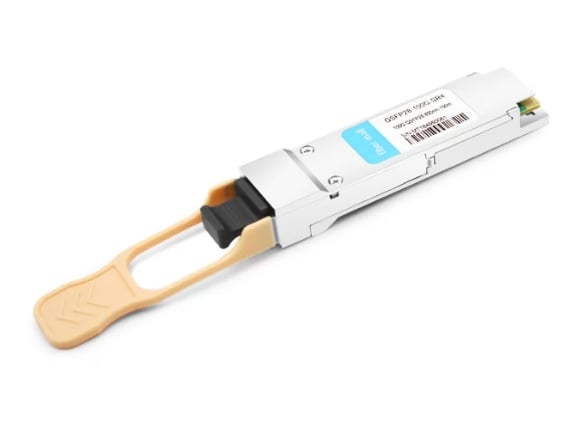
Q: What does an optical transceiver module mean in a Cisco 100G network?
A: A Cisco QSFP28 is a device that sends and receives data over fiber optic cables. It is important for high-speed communication, especially in 100G networks.
Q: In what ways does the QSFP28 optical transceiver module enhance the performance of a network?
A: The QSFP28 optical transceiver module improves performance by providing high bandwidth at low latency which makes it suitable for demanding applications. It supports 100GBase Ethernet to transmit data efficiently over long distances.
Q: How far can a Cisco QSFP28 optical transceiver module reach?
A: Different models of the Cisco QSFP28 optical transceiver modules have different distance coverage. For instance, the QSFP28 100GBase-DR single lambda 1310nm allows up to 500 meters, while its longer version, like the Cisco qsfp-100g-dr-s compatible, can go as far as about two kilometers when using single-mode fiber.
Q: Do other optics standards work with QSFP28 modules?
A: Yes, these modules support multiple optics standards. The qsfp28 MSA was developed to allow interoperability between various manufacturers and integration with different networking equipment.
Q: Which types of fiber optic cables are utilized in conjunction with Cisco qsfp28 transceivers?
A: Long-distance data transmission through connecting various network segments over vast distances is facilitated by Single Mode Fiber (SMF) cables used within Cisco QPSP28 Transceivers
Q: How can one be sure that their QSFP28 module will work with Cisco devices?
A: Check if it conforms to Cisco specifications such as the QSFP-100G-DR-S or other relevant ones like the Cisco QSFP-100G-ERL-S. Information regarding compatibility is often provided by manufacturers or suppliers of optical transceivers.
Q: Why should a person use a single lambda module compatible with Cisco?
A: Reliability, verified performance, and seamless integration with existing Cisco switches and routers are some of the advantages of using such modules, which ensure maximum network efficiency.
Q: Is it possible to use QSFP28 modules in Ethernet applications?
A: Indeed, these types of modules suit Ethernet applications best especially high-speed 100GBase Ethernet networks. Large-scale data transfer and communication require adequate bandwidth supply, which they provide.
Q: Can you recommend any particular model for short-range applications?
A: For short-range work where components are close together within data centers or network setups, consider using this model: QSFP-100G-SR4-S.
Q: What function do single lambda 1310nm optics serve in QSFP28 modules?
A: They simplify design and reduce costs while enabling long-distance transmission over fibers efficiently designed for higher-velocity light waves; therefore, they have become popular due to their balance between price and quality.
Related Products:
-
 Cisco QSFP-100G-LR4-S Compatible 100G QSFP28 LR4 1310nm (LAN WDM) 10km LC SMF DDM Transceiver Module
$285.00
Cisco QSFP-100G-LR4-S Compatible 100G QSFP28 LR4 1310nm (LAN WDM) 10km LC SMF DDM Transceiver Module
$285.00
-
 Cisco QSFP-40/100-SRBD Compatible Dual Rate 40G/100G QSFP28 BIDI 850nm & 900nm 100m LC MMF DDM Optical Transceiver
$449.00
Cisco QSFP-40/100-SRBD Compatible Dual Rate 40G/100G QSFP28 BIDI 850nm & 900nm 100m LC MMF DDM Optical Transceiver
$449.00
-
 Cisco Compatible 100G QSFP28 BIDI TX1331nm/RX1271nm PAM4 Single Lambda LC SMF 10km DDM Optical Transceiver Module
$500.00
Cisco Compatible 100G QSFP28 BIDI TX1331nm/RX1271nm PAM4 Single Lambda LC SMF 10km DDM Optical Transceiver Module
$500.00
-
 Cisco Compatible 100G QSFP28 BIDI TX1271nm/RX1331nm PAM4 Single Lambda LC SMF 10km DDM Optical Transceiver Module
$500.00
Cisco Compatible 100G QSFP28 BIDI TX1271nm/RX1331nm PAM4 Single Lambda LC SMF 10km DDM Optical Transceiver Module
$500.00
-
 Cisco QSFP-100G-ER4L-S Compatible 100G QSFP28 ER4 Lite1310nm (LAN WDM) 40km with FEC,30km without FEC LC SMF DDM Transceiver Module
$800.00
Cisco QSFP-100G-ER4L-S Compatible 100G QSFP28 ER4 Lite1310nm (LAN WDM) 40km with FEC,30km without FEC LC SMF DDM Transceiver Module
$800.00
-
 Cisco Compatible 100G DWDM QSFP28 C13 C14 100GHz CS DDM Optical Transceiver
$1600.00
Cisco Compatible 100G DWDM QSFP28 C13 C14 100GHz CS DDM Optical Transceiver
$1600.00
-
 Cisco QSFP-100G-CWDM4-S Compatible 100G QSFP28 CWDM4 1310nm 2km LC SMF DDM Transceiver Module
$110.00
Cisco QSFP-100G-CWDM4-S Compatible 100G QSFP28 CWDM4 1310nm 2km LC SMF DDM Transceiver Module
$110.00
-
 Cisco QSFP-100G-DR-S Compatible 100G QSFP28 Single Lambda DR 1310nm 500m LC SMF with FEC DDM Optical Transceiver
$180.00
Cisco QSFP-100G-DR-S Compatible 100G QSFP28 Single Lambda DR 1310nm 500m LC SMF with FEC DDM Optical Transceiver
$180.00
-
 Cisco QSFP-100G-4WDM-10-S Compatible 100G QSFP28 4WDM 10km LC SMF DDM Transceiver Module
$200.00
Cisco QSFP-100G-4WDM-10-S Compatible 100G QSFP28 4WDM 10km LC SMF DDM Transceiver Module
$200.00
-
 Cisco QSFP-100G-FR-S Compatible 100G QSFP28 Single Lambda FR 1310nm 2km LC SMF with FEC DDM Optical Transceiver
$215.00
Cisco QSFP-100G-FR-S Compatible 100G QSFP28 Single Lambda FR 1310nm 2km LC SMF with FEC DDM Optical Transceiver
$215.00
-
 Cisco QSFP-100G-SR1.2 Compatible Single Rate 100G QSFP28 BIDI 850nm & 900nm 100m LC MMF DDM Optical Transceiver
$280.00
Cisco QSFP-100G-SR1.2 Compatible Single Rate 100G QSFP28 BIDI 850nm & 900nm 100m LC MMF DDM Optical Transceiver
$280.00
-
 Cisco QSFP-100G-SR4-S Compatible 100G QSFP28 SR4 850nm 100m MTP/MPO MMF DDM Transceiver Module
$40.00
Cisco QSFP-100G-SR4-S Compatible 100G QSFP28 SR4 850nm 100m MTP/MPO MMF DDM Transceiver Module
$40.00
-
 Calix 100-01836 Compatible GPON OLT SFP TX-2.5G/RX-1.25G TX-1490nm/RX-1310nm Class B+ 40km SC SMF DDM Transceiver Modules
$30.00
Calix 100-01836 Compatible GPON OLT SFP TX-2.5G/RX-1.25G TX-1490nm/RX-1310nm Class B+ 40km SC SMF DDM Transceiver Modules
$30.00

